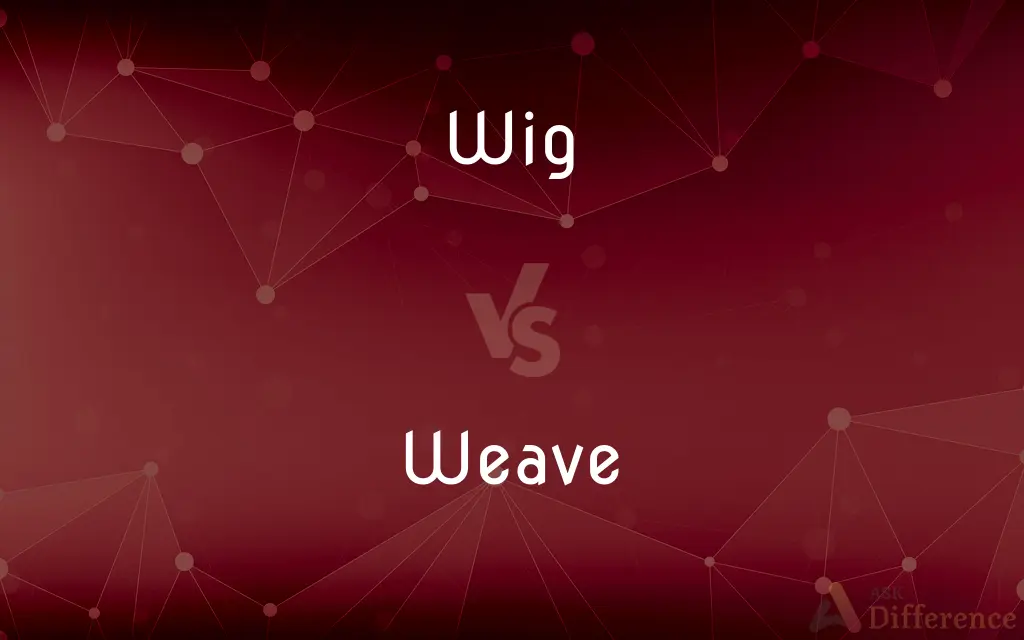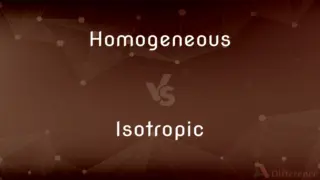Wig vs. Weave — What's the Difference?
By Tayyaba Rehman — Updated on September 21, 2023
Wig is a complete head covering made of human or synthetic hair. Weave is hair extensions sewn into natural hair to add length or volume. Wigs are worn on the outside, while weaves integrate with natural hair.

Difference Between Wig and Weave
Table of Contents
ADVERTISEMENT
Key Differences
A wig and a weave are both popular hair enhancement methods, but they serve different purposes and involve distinct application techniques. A wig is essentially a head covering made from human hair, animal hair, or synthetic fibers. It's designed to mimic the appearance of real hair and is worn for fashion, cosmetic, or other reasons such as medical hair loss. The wig can be easily put on or removed, offering a temporary and flexible option for changing hairstyles.
Conversely, a weave involves sewing hair extensions or tracks into one's natural, braided hair. This method is used primarily to add length, volume, or a different texture to natural hair. Unlike a wig, which can be taken off daily, a weave is semi-permanent and remains integrated with the wearer's natural hair for a specific period.
When considering the versatility, a wig provides the advantage of changing one's hairstyle daily without any commitment. In contrast, a weave requires a longer commitment and might need regular maintenance, depending on the type and method of installation. However, weaves offer a more natural integration with the existing hair, making it harder for others to detect.
It's important to note that both wigs and weaves can be made from a variety of materials, including human hair, synthetic fibers, or a blend of both. While some people might prefer wigs for their convenience and flexibility, others opt for weaves due to their more lasting nature and seamless blend with natural hair.
Comparison Chart
Definition
A complete head covering
Hair extensions integrated into natural hair
ADVERTISEMENT
Application
Worn on top of the head
Sewn or bonded into braided natural hair
Duration
Temporary; can be removed daily
Semi-permanent; lasts several weeks to months
Purpose
Change hairstyle, cover hair loss
Add length, volume, or change texture
Material Options
Human hair, synthetic, or blend
Human hair, synthetic, or blend
Compare with Definitions
Wig
An artificial hairpiece to replace or enhance natural hair.
After chemotherapy, he opted for a wig to regain confidence.
Weave
Hair extensions integrated with natural hair.
She got a weave to add some length to her short hair.
Wig
A head covering made of hair.
She bought a new wig for the costume party.
Weave
Tracks of hair sewn into braided hair.
The weave took hours, but the result was stunning.
Wig
A cosmetic accessory often used in fashion.
She wore a colorful wig to make a bold fashion statement.
Weave
To make (cloth) by interlacing the threads of the weft and the warp on a loom.
Wig
A wig is a head or hair accessory made from human hair, animal hair, or synthetic fiber. The word wig is short for periwig, which makes its earliest known appearance in the English language in William Shakespeare's The Two Gentlemen of Verona.
Weave
To interlace (threads, for example) into cloth.
Wig
An artificial covering of natural or synthetic hair worn on the head for personal adornment, as part of a costume, or to conceal baldness.
Weave
To construct by interlacing or interweaving strips or strands of material
Weave a basket.
Wig
To scold or censure.
Weave
To interweave or combine (elements) into a complex whole
Wove the incidents into a story.
Wig
A head of real or synthetic hair worn on the head to disguise baldness, for cultural or religious reasons, for fashion, or by actors to help them better resemble the character they are portraying.
Weave
To contrive (something complex or elaborate) in this way
Weave a tale.
Wig
A bigwig
Weave
To introduce (another element) into a complex whole; work in
Wove folk tunes into the symphony.
Wig
An old seal.
Weave
To attach hair extensions to (hair).
Wig
To put on a wig; to provide with a wig (especially of an actor etc.).
Weave
To spin (a web, for example).
Wig
To upbraid, reprimand.
Weave
Past tense & past participle often weaved To make (a path or way) by winding in and out or from side to side
Weaved our way through the heavy traffic.
Wig
To act in an extremely emotional way; to be overly excited, irritable, nervous, or fearful; behave erratically.
That guy must be high. Look how he's wigging.
Weave
To engage in weaving; make cloth.
Wig
To shoot in the head.
Weave
To work at a loom.
Wig
A covering for the head, consisting of hair interwoven or united by a kind of network, either in imitation of the natural growth, or in abundant and flowing curls, worn to supply a deficiency of natural hair, or for ornament, or according to traditional usage, as a part of an official or professional dress, the latter especially in England by judges and barristers.
Weave
Past tense and past participle often weaved To move in and out or sway from side to side.
Wig
An old seal; - so called by fishermen.
Weave
The pattern, method of weaving, or construction of a fabric
A twill weave.
A loose weave.
Wig
To censure or rebuke; to hold up to reprobation; to scold.
Weave
A hairstyle in which hair extensions are attached to existing strands of hair.
Wig
Hairpiece covering the head and made of real or synthetic hair
Weave
To form something by passing lengths or strands of material over and under one another.
This loom weaves yarn into sweaters.
Wig
British slang for a scolding
Weave
To spin a cocoon or a web.
Spiders weave beautiful but deadly webs.
Wig
A temporary solution for hair loss or style change.
For the film role, the actor wore a long wig.
Weave
To unite by close connection or intermixture.
Wig
A full cap of hair, either synthetic or real.
The wig looked so natural that nobody could tell the difference.
Weave
To compose creatively and intricately; to fabricate.
To weave the plot of a story
Weave
(intransitive) To move by turning and twisting.
The drunk weaved into another bar.
Weave
(transitive) To make (a path or way) by winding in and out or from side to side.
The ambulance weaved its way through the heavy traffic.
Weave
To move the head back and forth in a stereotyped pattern, typically as a symptom of stress.
Weave
A type or way of weaving.
That rug has a very tight weave.
Weave
(cosmetics) Human or artificial hair worn to alter one's appearance, either to supplement or to cover the natural hair.
Weave
To unite, as threads of any kind, in such a manner as to form a texture; to entwine or interlace into a fabric; as, to weave wool, silk, etc.; hence, to unite by close connection or intermixture; to unite intimately.
This weaves itself, perforce, into my business.
That in their green shops weave the smooth-haired silkTo deck her sons.
And for these words, thus woven into song.
Weave
To form, as cloth, by interlacing threads; to compose, as a texture of any kind, by putting together textile materials; as, to weave broadcloth; to weave a carpet; hence, to form into a fabric; to compose; to fabricate; as, to weave the plot of a story.
When she weaved the sleided silk.
Her starry wreaths the virgin jasmin weaves.
Weave
To practice weaving; to work with a loom.
Weave
To become woven or interwoven.
Weave
A particular method or pattern of weaving; as, the cassimere weave.
Weave
Pattern of weaving or structure of a fabric
Weave
Interlace by or as it by weaving
Weave
Create a piece of cloth by interlacing strands of fabric, such as wool or cotton;
Tissue textiles
Weave
Sway to and fro
Weave
To move or cause to move in a sinuous, spiral, or circular course;
The river winds through the hills
The path meanders through the vineyards
Sometimes, the gout wanders through the entire body
Weave
A method to enhance natural hair's volume or length.
The stylist recommended a weave for her thinning hair.
Weave
A semi-permanent hair solution.
She maintains her weave every few weeks to keep it looking fresh.
Weave
Strands added to natural hair for a fuller look.
The weave blended seamlessly with her natural curls.
Common Curiosities
Can wigs look natural?
Yes, high-quality wigs, especially those made from human hair, can look very natural.
How long can a weave last?
A weave can last anywhere from several weeks to a few months with proper care.
What is a wig?
A wig is a complete head covering made from human or synthetic hair.
Can men wear wigs?
Absolutely, wigs are available for both men and women.
How is a weave different from a wig?
A weave is sewn into braided natural hair, while a wig is worn over the scalp.
How do I care for a wig?
Depending on the material, wigs require regular cleaning, conditioning, and gentle brushing.
Can I wear a wig daily?
Yes, but ensure you take care of both the wig and your natural scalp and hair.
How is a weave installed?
Weaves are typically sewn, glued, or clipped into natural, braided hair.
Is it painful to get a weave?
Proper installation shouldn't be painful, but tight braids or weaves might cause discomfort.
Why do people wear wigs?
Reasons vary from style preferences, hair loss, medical conditions, or fashion choices.
Do weaves damage natural hair?
If installed or maintained incorrectly, weaves can cause tension or damage to natural hair.
Are wigs expensive?
The cost varies based on material and craftsmanship; human hair wigs tend to be pricier.
Do wigs provide a natural hairline?
Lace front wigs are designed to give a more natural hairline appearance.
Can I color or style my weave?
Yes, especially if it's made of human hair. But always consult with a professional first.
Can I swim with a weave?
Yes, but it's advisable to wear a swim cap or wash and condition the weave afterward.
Share Your Discovery

Previous Comparison
Homogeneous vs. Isotropic
Next Comparison
Genome vs. GeneAuthor Spotlight
Written by
Tayyaba RehmanTayyaba Rehman is a distinguished writer, currently serving as a primary contributor to askdifference.com. As a researcher in semantics and etymology, Tayyaba's passion for the complexity of languages and their distinctions has found a perfect home on the platform. Tayyaba delves into the intricacies of language, distinguishing between commonly confused words and phrases, thereby providing clarity for readers worldwide.














































